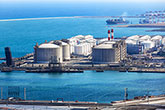Yara drives hydrogen economy with new ammonia import terminal
Published by Poppy Clements,
Assistant Editor
Tanks and Terminals,
With the new terminal, Yara has the infrastructure to enable imports of up to 3 million t of low-emission ammonia to Europe annually.
The terminal is part of Yara's strategy to strengthen its core nitrogen business while generating value-accretive growth in a low-carbon future.
“As the world’s largest shipper and distributer of ammonia, Yara Clean Ammonia is in a pole position to secure low-emission ammonia supply to Germany, at competitive prices. With its global ammonia position, Yara can help kick-start the German hydrogen economy, laying the ground for a net zero future,” said Hans Olav Raen, CEO Yara Clean Ammonia. Up to 3 million t of low-CO2 ammonia can be imported annually via the terminal in Brunsbüttel. This would correspond to 530 000 t of hydrogen or around 5% of the total European hydrogen target for 2030.
With its significant import capacity, Yara’s new terminal in Brunsbüttel will play an important role in enabling the German hydrogen strategy and contribute to the country’s energy transition. Uniquely located on the North Sea and the Kiel Canal, Brunsbüttel is ideally placed to become a central hub, not only for Germany, but also for Europe's hydrogen economy.
“For 50 years, we have been manufacturing products of fundamental importance to Germany and Europe here at the Brunsbüttel site. Today's inauguration represents a new milestone and an important step towards a low-carbon future,” stated Sven Kohnke, Plant Manager, Yara Brunsbüttel.
The ammonia can be delivered directly from the terminal to the point of use, where it could be cracked to low-emission hydrogen. The competitiveness of German industry, not least steel and chemicals, can only be maintained through decarbonisation. This can be achieved through cracking low-emission ammonia to hydrogen, for which significant quantities of ammonia will be needed.
Low-emission ammonia is produced by electrolysis using renewable electricity or using carbon capture and storage (CCS). Low-emission ammonia has key advantages that makes it attractive as a decarbonisation product in hard-to-abate sectors. This includes the traditional ammonia use such as fertilizers but also new applications such as a low-emission shipping fuel, emission cuts for refineries, power generation, and as a hydrogen carrier.
Demand for low-emission ammonia in Germany is expected to increase significantly in the coming years. The Federal Ministry for Economic Affairs and Climate Protection estimates that up to 70% of future national ammonia requirements will have to be imported by 2030. After this, the volumes will be even higher.
Read the article online at: https://www.tanksterminals.com/terminals/03102024/yara-drives-hydrogen-economy-with-new-ammonia-import-terminal/
You might also like
Hydrocarbon Engineering Podcast
Peter Davidson, CEO of the Tank Storage Association (TSA), joins us to discuss the essential role that the tank storage sector has to play in ensuring supply security and resilience, as well as in facilitating the energy transition.
JCEDF hosts groundbreaking ceremony for BWC Terminals’ new facility
Jackson County Economic Development Foundation (JCEDF) has hosted a groundbreaking ceremony for BWC Terminals’ new facility in Pascagoula, Mississippi, US, which will receive, store, and deliver petroleum products.


